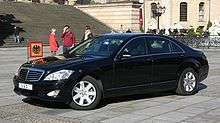Armored car (VIP)


A civilian armored car is a security vehicle which is made by replacing the windows of a standard vehicle (typically a limousine or SUV) with bulletproof glass and inserting layers of armor plate into the body panels. Unlike a military armored car, which has armor plate mounted on the outside of the vehicle, a civilian armored car typically looks no different from a standard vehicle.
Design
Civilian armored cars are either (in the majority of cases) retrofitted versions of series cars, or (in only a few cases) factory produced, such as the Audi Security Vehicles (A6 & A8), Lincoln Town Car BPS, the Hyundai Equus, the BMW Security series (3 Series Security, 5 Series Security, X5 Security & Security Plus and 7 Series High-Security), the Mercedes Benz Guard vehicles (E, ML, GL, G & S Class). Civilian armored cars may have obvious armor protection such as the Knight XV, or they may be totally indistinguishable from an unarmored model. There are also armored variants of smaller cars, such as the VW Golf, to further conceal their function and capabilities. Large SUVs such as LX 570 are sometimes used as armored vehicles. Some civilian armored cars may be one-off unique vehicles with no regular equivalent, such as the current Presidential state car of the USA which is medium-duty truck platform styled like a Cadillac.
An armored vehicle is made by replacing the windows with bulletproof glass and inserting layers of armor plate under the outer skin of the car, a labor-intensive process that generally takes a few weeks and most often costs upward of $100,000 USD. The makers usually leave the external appearance of the car unchanged, in order that it look as inconspicuous as possible. In most cases materials like Aramid (e.g. Kevlar), HMPE (e.g. Dyneema), composites or ballistic stainless steel plates are used.
Besides the armor itself, many other protective modifications are available: automatic fire extinguishers, run-flat tires, an explosion-resistant fuel tank, remote starting of the car, CCTV Vehicle Camera Systems, GPS link, pressure and temperature control of the tires, a siren or alarm, and an intercom between the exterior and interior of the car, and a PA system, so that the bodyguards inside the car can communicate via a megaphone to individuals outside the car. Sometimes the inside can be sealed or over-pressured, using its own air supply, to protect against poison gas or tear gas attacks. As a side benefit, armored cars give occupants added protection from intrusion during car accidents.
The increased mass of the added armor and protective modifications is offset by a more powerful engine and brakes and stronger shock absorbers. The increased weight means that the mechanical parts of an armored car are subjected to higher forces than normal, which in turn reduces the service life of the car, though this may be offset somewhat by using heavy duty components not normally found in the security vehicle's regular counterpart.
Usage
Armored cars may be provided by governments for elected officials and senior officials who are at risk. Sometimes regular officials, public servants, and controversial figures may be protected with armored vehicles in higher-risk situations. Diplomatic missions and private military contractors typically use armored cars as standard vehicles.
Due to the sizable weight of the added armor that can substantially affect the handling of the armored car, drivers of these vehicles typically have specialized training in tactical driving. This training is provided by bodyguard schools and by police and military units (e.g., the United States Secret Service).
The armored car of a high-profile government official is often part of a motorcade consisting of dozens of other vehicles, including security, police, first aid ambulance, the press, and route-clearing, among others.
Certification
There are a variety of armoring standards[1][2]which relate to non-military armored vehicles, the most common are:
- Ballistics Rating (BR): This is a European standard which certifies the materials used both transparent (BR - DIN EN 1063) and opaque (FB - DIN EN 1522/23), general guidelines on vehicle construction and covers 3 levels from 2 to 7 . This is usually grouped under a single definition of B, e.g B6
- Vereinigung der Prüfstellen fur Angriffshernmede Materialien und Konstruktionen (VPAM)[3] - VPAM have a number of standards that relate to non-military armored vehicles, they are:
- APR 2006 - These are the general test guidelines for armoured products.
- PM 2007 - This covers the materials used.
- BRV 1999 and 2009 - This certification indicates that the whole vehicle has been tested instead of just the materials used.
- ERV 2010 - Blast protection certification.
- Vehicle Security Advisory Group (VASG) - A British Standard for armored car construction and testing.
- National Institute for Justice (NIJ) - The American National Institute of Justice certification, covers body armour as well as vehicles and covers 5 levels.
